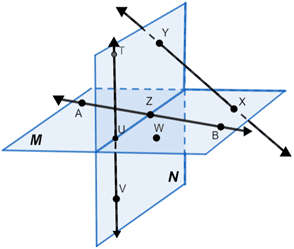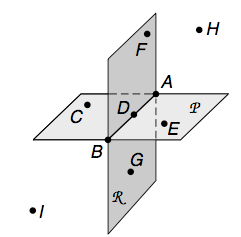d=√(x2-x1)2+(y2-y1)2
What is the distance formula?
Three collinear points in Plane N
What are points T, U, and V
An obtuse angle.
What is an angle larger than 90° but smaller than 180°?
(x1+x2)/2 + (y1+y2)/2
What is the midpoint formula?
Two ∠'s made up of the same two lines.
What are vertical angles?
Given d=√(2+1)2+(2+3)2 answer in simpliest radical form
What is √34
The intersection of Planes P and R.
What is line AB
The midpoint of these two points (3,2) (1,-4).
What is (2,-1)
Two ∠'s that add up to 90°.
What are complementary angles?
The distance between these two points (7,4) (8,16).
What is 5
The length of CD
What is 6
The sum of adjacent angles is equal to the overall angle.
What is the angle addition postulate?
The missing endpoint with the given one endpoint (2,1) and the midpoint (4,2).
What is (2,-1)
Two ∠'s that add up to 180°.
What are supplementary angles?
The formula a2+b2=c2
What is pythagorean theorem?
The length of DF given
What is DF =18
Two angles that share a common side and vertex, but have no common interior points.
What are adjacent angles?
Find the midpoint between (-10/11,9/13) (6/11,-11/13).
What is (-2/11,-1/13)
If ∠A=12x+1 and ∠B=x+10 are supplementary. Find The obtuse angle
What is m∠A=157°
The measure of leg B of the triangle ABC, if leg AB is 8 cm and the hypotenuse AC is 10 cm.
What is BC=6 cm
Use the Distance Formula to decide whether PQ≅QR. P(-1,-6) Q(-8,5) R(3,-2)
Keep distances in simpliest radical form.
What is PQ≅QR PQ=√170 QR=√170
If m∠ABD=38° and m∠DBC=49° then what type of angle is ∠ABC?
What is an acute angle
Find the other endpoint with the given endpoint (¾,-½) and midpoint (5/8,-9/10).
What is (1/2,-13/10)
If ∠CEA (y+20)° and ∠CEB (4y-15)° are a linear pair, then find y.
y=35
